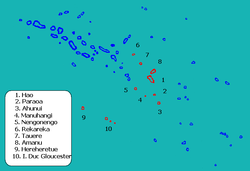 NASA picture of Hao Atoll | |
| Geography | |
|---|---|
| Location | Pacific Ocean |
| Coordinates | 18°4′31″S 140°56′43″W / 18.07528°S 140.94528°W |
| Archipelago | Tuamotus |
| Area | 720 km2 (280 sq mi) (lagoon) 35 km2 (14 sq mi) (above water) |
| Length | 50 km (31 mi) |
| Width | 14 km (8.7 mi) |
| Highest elevation | 3 m (10 ft) |
| Administration | |
France | |
| Overseas collectivity | French Polynesia |
| Administrative subdivision | Îles Tuamotu-Gambier |
| Commune | Hao |
| Largest settlement | Otepa |
| Demographics | |
| Population | 1009[1] (2022) |
Hao | |
|---|---|
 | |
| Coordinates: 18°04′31″S 140°56′43″W / 18.0753°S 140.9453°W | |
| Country | France |
| Overseas collectivity | French Polynesia |
| Subdivision | Îles Tuamotu-Gambier |
| Government | |
| • Mayor (2020–2026) | Yseult Butcher[2] |
| Area 1 | 65.0 km2 (25.1 sq mi) |
| Population (2022)[1] | 1,227 |
| • Density | 19/km2 (49/sq mi) |
| Time zone | UTC−10:00 |
| INSEE/Postal code | 98720 /98767 |
| Elevation | 0–3 m (0.0–9.8 ft) |
| 1 French Land Register data, which excludes lakes, ponds, glaciers > 1 km2 (0.386 sq mi or 247 acres) and river estuaries. | |
Hao, or Haorangi,[3] is a large coral atoll in the central part of the Tuamotu Archipelago. It has c. 1000 people living on 35 km2 (14 sq mi). It was used to house the military support base for the nuclear tests on Mururoa. Because of its shape, French explorer Louis Antoine de Bougainville named it "Île de la Harpe" (Harp Island).
- ^ a b "Les résultats du recensement de la population 2022 de Polynésie française" [Results of the 2022 population census of French Polynesia] (PDF) (in French). Institut de la statistique de la Polynésie française. January 2023.
- ^ "Répertoire national des élus: les maires" (in French). data.gouv.fr, Plateforme ouverte des données publiques françaises. 4 May 2022.
- ^ Young, J.L. (1899). "Names of the Paumotu Islands, with the old names so far as they are known". Journal of the Polynesian Society. 8 (4): 264–268. Archived from the original on 10 February 2012. Retrieved 7 January 2015.


